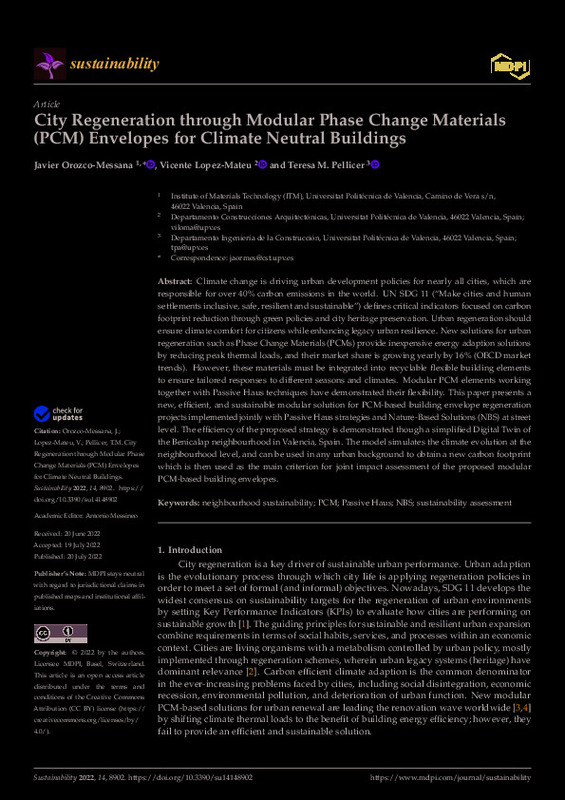JavaScript is disabled for your browser. Some features of this site may not work without it.
Buscar en RiuNet
Listar
Mi cuenta
Estadísticas
Ayuda RiuNet
Admin. UPV
City Regeneration through Modular Phase Change Materials (PCM) Envelopes for Climate Neutral Buildings
Mostrar el registro sencillo del ítem
Ficheros en el ítem
| dc.contributor.author | Orozco-Messana, Javier
|
es_ES |
| dc.contributor.author | Lopez-Mateu, Vicente
|
es_ES |
| dc.contributor.author | Pellicer, Teresa M.
|
es_ES |
| dc.date.accessioned | 2023-02-13T19:00:37Z | |
| dc.date.available | 2023-02-13T19:00:37Z | |
| dc.date.issued | 2022-07 | es_ES |
| dc.identifier.uri | http://hdl.handle.net/10251/191801 | |
| dc.description.abstract | [EN] Climate change is driving urban development policies for nearly all cities, which are responsible for over 40% carbon emissions in the world. UN SDG 11 ("Make cities and human settlements inclusive, safe, resilient and sustainable") defines critical indicators focused on carbon footprint reduction through green policies and city heritage preservation. Urban regeneration should ensure climate comfort for citizens while enhancing legacy urban resilience. New solutions for urban regeneration such as Phase Change Materials (PCMs) provide inexpensive energy adaption solutions by reducing peak thermal loads, and their market share is growing yearly by 16% (OECD market trends). However, these materials must be integrated into recyclable flexible building elements to ensure tailored responses to different seasons and climates. Modular PCM elements working together with Passive Haus techniques have demonstrated their flexibility. This paper presents a new, efficient, and sustainable modular solution for PCM-based building envelope regeneration projects implemented jointly with Passive Haus strategies and Nature-Based Solutions (NBS) at street level. The efficiency of the proposed strategy is demonstrated though a simplified Digital Twin of the Benicalap neighbourhood in Valencia, Spain. The model simulates the climate evolution at the neighbourhood level, and can be used in any urban background to obtain a new carbon footprint which is then used as the main criterion for joint impact assessment of the proposed modular PCM-based building envelopes. | es_ES |
| dc.description.sponsorship | This research was co-funded by the European Commission through the H2020 project "Green Cities for Climate and Water Resilience, Sustainable Economic Growth, Healthy Citizens and Environments (GROW GREEN)" Grant Agreement: 730283. | es_ES |
| dc.language | Inglés | es_ES |
| dc.publisher | MDPI AG | es_ES |
| dc.relation.ispartof | Sustainability | es_ES |
| dc.rights | Reconocimiento (by) | es_ES |
| dc.subject | Neighbourhood sustainability | es_ES |
| dc.subject | PCM | es_ES |
| dc.subject | Passive Haus | es_ES |
| dc.subject | NBS | es_ES |
| dc.subject | Sustainability assessment | es_ES |
| dc.subject.classification | CONSTRUCCIONES ARQUITECTONICAS | es_ES |
| dc.subject.classification | CIENCIA DE LOS MATERIALES E INGENIERIA METALURGICA | es_ES |
| dc.subject.classification | INGENIERIA DE LA CONSTRUCCION | es_ES |
| dc.title | City Regeneration through Modular Phase Change Materials (PCM) Envelopes for Climate Neutral Buildings | es_ES |
| dc.type | Artículo | es_ES |
| dc.identifier.doi | 10.3390/su14148902 | es_ES |
| dc.relation.projectID | info:eu-repo/grantAgreement/EC/H2020/730283/EU | es_ES |
| dc.rights.accessRights | Abierto | es_ES |
| dc.contributor.affiliation | Universitat Politècnica de València. Escuela Técnica Superior de Arquitectura - Escola Tècnica Superior d'Arquitectura | es_ES |
| dc.contributor.affiliation | Universitat Politècnica de València. Escuela Técnica Superior de Gestión en la Edificación - Escola Tècnica Superior de Gestió en l'Edificació | es_ES |
| dc.contributor.affiliation | Universitat Politècnica de València. Escuela Técnica Superior de Ingenieros de Caminos, Canales y Puertos - Escola Tècnica Superior d'Enginyers de Camins, Canals i Ports | es_ES |
| dc.description.bibliographicCitation | Orozco-Messana, J.; Lopez-Mateu, V.; Pellicer, TM. (2022). City Regeneration through Modular Phase Change Materials (PCM) Envelopes for Climate Neutral Buildings. Sustainability. 14(14):1-12. https://doi.org/10.3390/su14148902 | es_ES |
| dc.description.accrualMethod | S | es_ES |
| dc.relation.publisherversion | https://doi.org/10.3390/su14148902 | es_ES |
| dc.description.upvformatpinicio | 1 | es_ES |
| dc.description.upvformatpfin | 12 | es_ES |
| dc.type.version | info:eu-repo/semantics/publishedVersion | es_ES |
| dc.description.volume | 14 | es_ES |
| dc.description.issue | 14 | es_ES |
| dc.identifier.eissn | 2071-1050 | es_ES |
| dc.relation.pasarela | S\474410 | es_ES |
| dc.contributor.funder | European Commission | es_ES |








